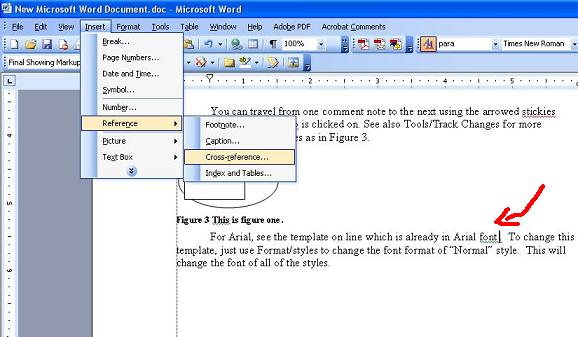

What I would like to do is to preserve these entries when I open the word document (.doc and not. But everything else is as it would appear in the field codes in MS Word 2003. These cross references do not use an asterix, I just put the asterix there instead of typing out the figure or table name.
#WORD CROSS REFERENCE FIGURE CODE#
The MS Word code for my figure and table cross references looks something like: My word documents use a Fig_Title and Table_Title style for the typical figure titles and table titles. Is there a way to adjust FrameMaker's import filter, so that it will pull in these cross references?

These references typically sit in the paragraph text style I use in MS Word, but after converting to FrameMaker, they are no long there. When I open the word document in FrameMaker 8, everything works great except that my figure and cross references are not seen. You can use a master document to set up and manage a multi-part document, such as a book with several chapters.I am trying to preserve my figure and table cross references when I import my Word 2003 document into (Unstructured) FrameMaker 8. A master document is a container for a set of separate files (or subdocuments). If you want to cross-reference items that reside in a separate document but don't want to use hyperlinks, you'll have to first combine the documents into one master document and then insert the cross-references. To see the field results instead of field codes, press ALT+F9, or right-click the field code, and then click Toggle Field Codes on the shortcut menu. When you print the document or hide field codes, the field results replace the field codes. If you've inserted a cross-reference and it looks similar to, then Word is displaying field codes instead of field results.
#WORD CROSS REFERENCE FIGURE UPDATE#
Similarly, if you update a graphic that's stored elsewhere but referenced in the field, the update will get picked up automatically without you having to re-insert the graphic. For example, if you're writing a document over a period of days, the date will change each day when you open and save the document. The advantage of using fields is that the content being inserted-date, page number, graphics, etc.-gets updated for you whenever there's a change. For example, the DATE field inserts the current date. A field is a set of information that instructs Word to insert text, graphics, page numbers, and other material into a document automatically. If the Include above/below check box is available, check it to include specify the relative position of the referenced item.Ĭross-references are inserted into your document as fields.

To allow users to jump to the referenced item, select the Insert as hyperlink check box. In the For which box, click the specific item you want to refer to, such as "Insert the cross-reference." Choices depend on what you chose in step 3. In the Insert reference to box, click the information you want inserted in the document. The list of what's available depends on the type of item (heading, page number, etc.) you're linking to. In the Reference type box, click the drop-down list to pick what you want to link to. On the Insert tab, click Cross-reference. For example, "See Figure 2 for an explanation of the upward trend." In the document, type the text that begins the cross-reference. When you insert the cross-reference, you'll see a dialog box that lists everything that's available to link to. You can't cross-reference something that doesn't exist, so be sure to create the chart, heading, page number, etc., before you try to link to it. Create the item you're cross-referencing first If you want to link to a separate document you can create a hyperlink. The cross-reference appears as a link that takes the reader to the referenced item. For example, you might use a cross-reference to link to a chart or graphic that appears elsewhere in the document. LessĪ cross-reference allows you to link to other parts of the same document.


 0 kommentar(er)
0 kommentar(er)
